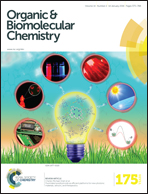Design, synthesis and evaluation of N-aryl-glyoxamide derivatives as structurally novel bacterial quorum sensing inhibitors†
Abstract
Bacteria cooperatively regulate the expression of many phenotypes through a mechanism called quorum sensing (QS). Many Gram-negative bacteria use an N-acyl homoserine lactone (AHL)-mediated QS system to control biofilm formation and virulence factor production. In recent years, quorum sensing inhibitors (QSIs) have become attractive tools to overcome antimicrobial resistance exhibited by various pathogenic bacteria. In the present study, we report the design and synthesis of novel N-arylisatin-based glyoxamide derivatives via the ring-opening reaction of N-aryl isatins with cyclic and acylic amines, and amino acid esters. The QSI activity of the synthesized compounds was determined in the LasR-expressing Pseudomonas aeruginosa MH602 and LuxR-expressing Escherichia coli MT102 reporter strains. Compounds 31 and 32 exhibited the greatest QSI activity in P. aeruginosa MH602, with 48.7% and 42.7% reduction in QS activity at 250 μM, respectively, while compounds 31 and 34 showed 73.6% and 43.7% QSI activity in E. coli MT102. In addition, the ability of these compounds to inhibit the production of pyocyanin in P. aeruginosa (PA14) was also determined, with compound 28 showing 47% inhibition at 250 μM. Furthermore, computational docking studies were performed on the LasR receptor protein of P. aeruginosa, which showed that formation of a hydrogen bonding network played a major role in influencing the QS inhibitory activity. We envisage that these novel non-AHL glyoxamide derivatives could become a new tool for the study of QS and potentially for the treatment of bacterial infections.


 Please wait while we load your content...
Please wait while we load your content...